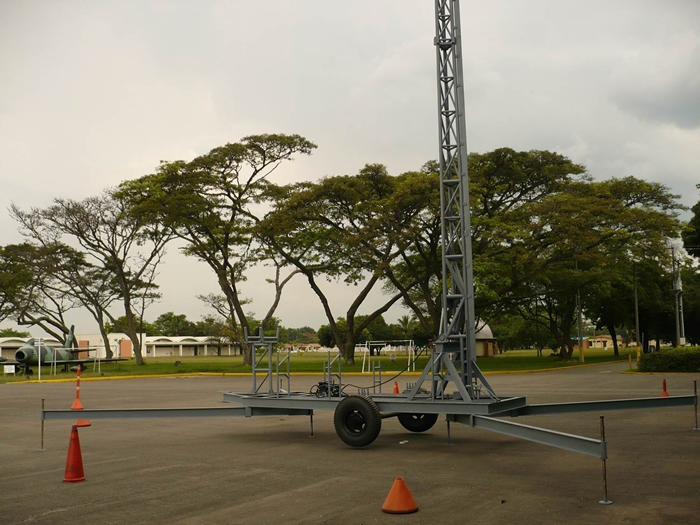Simulation of a Two Stage Rocket Trajectory to Place a Nanosatellite into Orbit
DOI:
https://doi.org/10.18667/cienciaypoderaereo.139Keywords:
Flight Path, Liquid Rocket, Low Earth Orbit (LEO), Nano - SatelliteAbstract
This article aims to study the possibility of launching a two-stage liquid propellant rocket in order to put into orbit a 4 Kg payload, equivalent to the mass of a 3U CubeSat. It presents a study with a conceptual design of the carrier rocket implementing a computer optimization code in order to reduce mass and increase takeoff speed. As a launch site the Air Force Base named Grupo Aéreo del Oriente (GAORI) in Marandua, State of Vichada, Colombia, was chosen, due to the fact that there is research in rocketry currently carried out there, and that the place has been used by universities for development of such investigations. Results were input into a computer code in FORTRAN developed at the National Astronomical Observatory of the National University of Colombia in order to study the flight path of the rocket during its ascent phase and entrance into orbit.
Downloads
References
Fleeman, E. (2006). Tactical Missile Design. 2Ed. AIAA, Virginia.
Fostescue, P. Stark, J., y Swinerd, G. (2003). Spacecraft Systems Engineering. 3 Ed. Londres: Wiley.
Galli, P., y Rochus, S. (2008). Mision Design for the Cubesat OUTFI-1. Tesis en Ingeniería Civil - Electromecánica, Universidad de Liege.
Gutiérrez, R. (2012). Programa Espacial FAC, Avances y Proyección. Cuarto Congreso Colombiano en Ciencia y Tecnología Aeroespacial CICTA 2012. Bogotá: Universidad Distrital Francisco José de Caldas
Humble, R., Henry, G., y Larson, W. (1995). Space Propulsion Analysis and Design. New York: Mc Graw Hill.
Joya, R. (2007). Desarrollo de Nuevas Tecnologías, Primer Satélite Colombiano en el Espacio, Libertad 1. Rev. Ciencia y Tecnología, Vol. 25 (2), pp. 46-51. Bogotá: Colciencias.
Minzner, R. A., Champion K.S.W., y Pond, H.L. (1959). The ARDC model atmosphere, 1959. Air Force Surveys in Geophysics N°115. Cambridge.
Portilla, J. (2009). Elementos de Astronomía de Posición. Bogotá: UNIBIBLOS.
Sutton, G., y Biblatz, O. (2010). Rocket Propulsion Elements, 8 Ed. New York: John Wiley and Sons.
Tewari, A. (2006). Atmospheric and Space Flight Dynamics. Berlín: Birkhauser.
Urrego, A. (2009). Investigaciones en Cohetería Experimental. Misión Séneca, Lanzamiento del Cohete Ainkaa 1. Tesis de Pregrado en Ingeniería Mecánica. Bogotá: Universidad de los Andes.
Weiland, C. (2010). Computational Space Flight Mechanics. Berlín: Springer.
https://doi.org/10.1007/978-3-642-13583-5
Zipfel, P. (2007). Modeling and Simulation of Aerospace Vehicle Dynamics. 2Ed. AIAA, Virginia

Downloads
Issue
Section
License
Assignment of Copyrights
Authors assign Ciencia y Poder Aéreo journal the exclusive rights (reproduction, distribution, public communication, and transformation) to exploit and commercialize their work, in whole or in part, in all the formats and modalities of present or future exploitation, in all languages, throughout the life of the work and throughout the world.
All contents published in Ciencia y Poder Aéreo journal are licensed under a Creative Commons Attribution 4.0 International License, whose complete information is available at http://creativecommons.org/licenses/by/4.0/
Under the terms of this license, users are free to download, print, extract, archive, distribute and publicly communicate the content of articles, provided that proper credit is granted to authors and Ciencia y Poder Aéreo, scientific journal of the Graduate School of the Colombian Air Force. Except when otherwise indicated, this site and its contents are licensed under a Creative Commons Attribution 4.0 International License.
For other uses not considered under this license it is required to contact the Director or the Editor of the journal at the e-mail address cienciaypoderaereo1@gmail.com.
The Graduate School of the Colombian Air Force and this publication are not responsible for the concepts expressed in the articles, including the metadata or the affiliation stated by authors. This is the full responsibility of the authors.





















